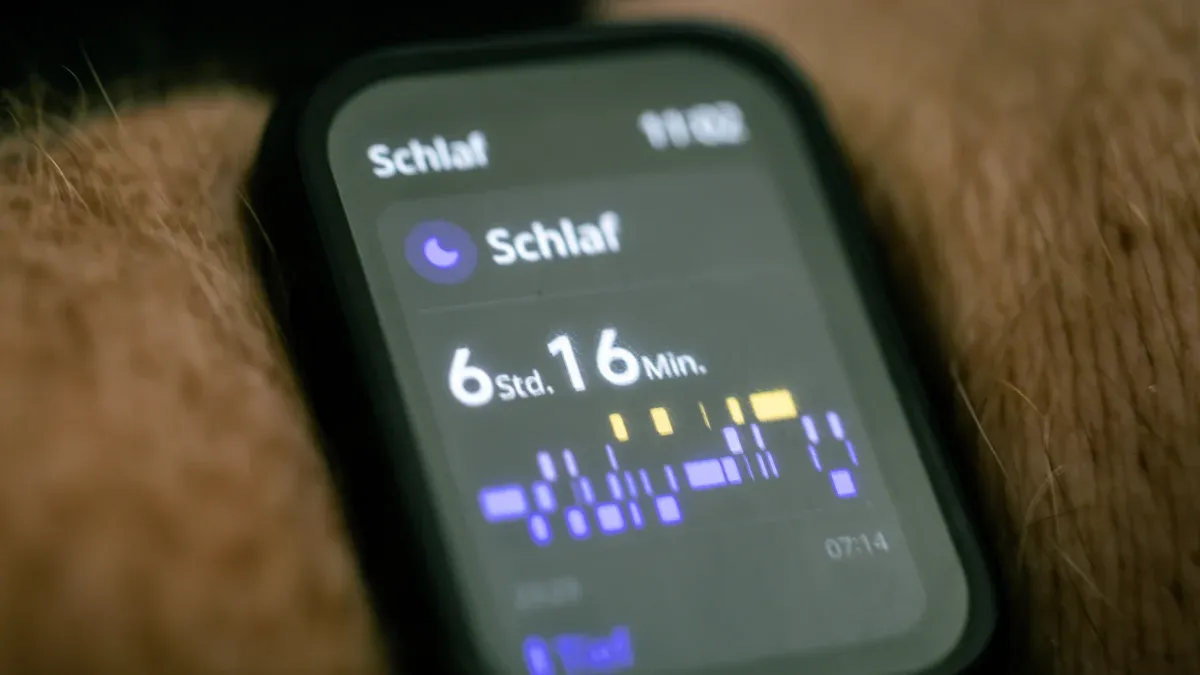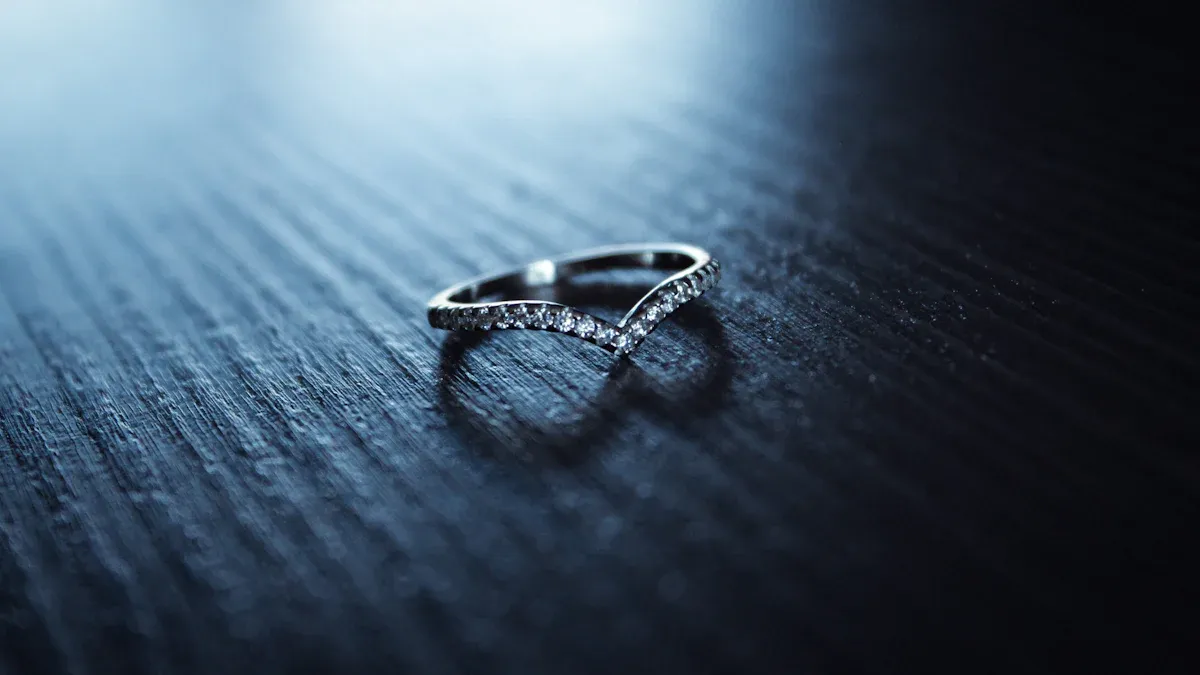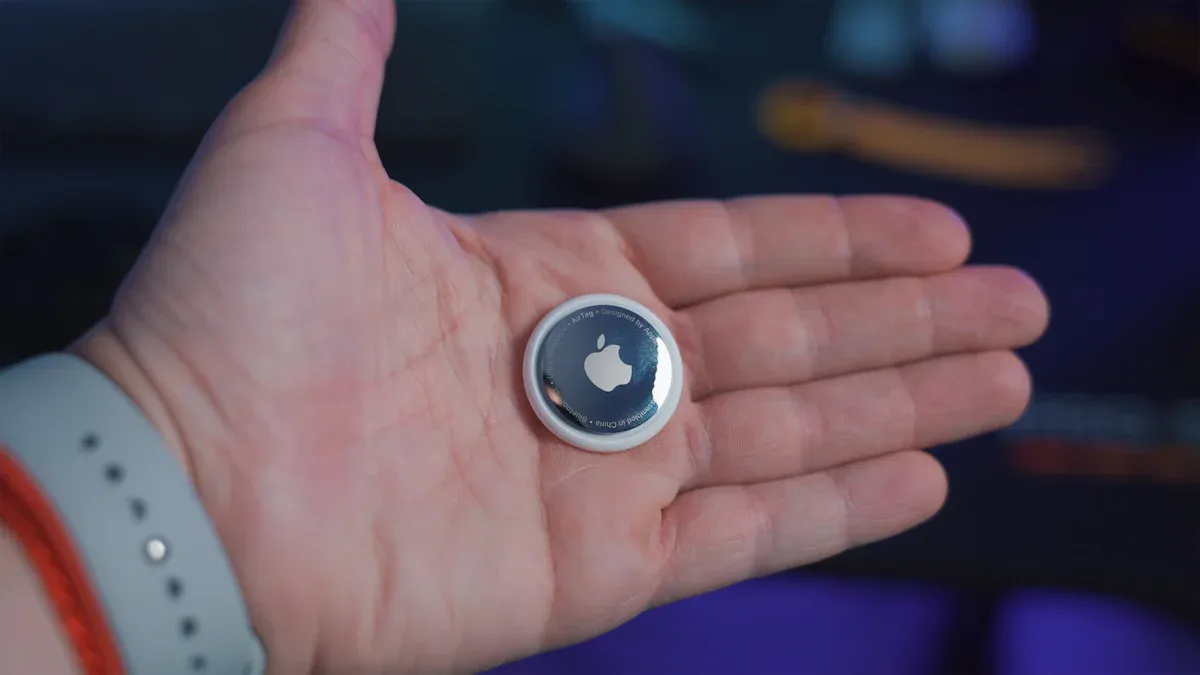
Smart rings are changing how people check their health. These cool gadgets use special sensors and wearable tech to track health instantly without causing pain. Many wonder, do the rings with health sensors work? Wearing one gives you useful information to make better health choices. The smart rings market is growing fast, expected to jump from $1.5 billion in 2023 to $4.7 billion by 2032. With tools like heart rate checks and blood sugar tracking, smart rings make it easy to manage your health.
Key Takeaways
-
Smart rings check your health in real-time, tracking things like heart rate and sleep easily.
-
They use special sensors to give you personal health tips, helping you make better choices for your wellness.
-
Smart rings are easy to wear and don’t bother you, so you can track your health while doing daily tasks.
-
Use the info from your smart ring to set simple health goals, like sleeping better or moving more.
-
Smart rings help you take care of your health, but they should not replace advice from a doctor.
What Are Smart Rings and How Do They Work?
Definition and purpose of smart rings
Smart rings are small devices worn on your finger. They use advanced sensors to check your health in real-time. Unlike big gadgets, these rings are stylish and easy to wear. They turn health data into simple tips to improve your wellness. For example, they can track your heart rate, sleep, and stress. Their goal is not just tracking but helping you stay healthier with useful advice.
|
Feature |
Description |
|---|---|
|
Compact Design |
A small, comfortable device for checking your health. |
|
Continuous Health Monitoring |
Gives real-time updates on your body’s health. |
|
Sleep Tracking |
Watches your sleep to help you rest better. |
|
Heart Rate Monitoring |
Tracks your heart rate for fitness and heart health. |
|
Stress Management |
Offers tools like breathing exercises to reduce stress. |
How do the rings with health sensors work?
Smart rings use special sensors to gather health information. PPG sensors check your heart rate and oxygen levels with high accuracy. Motion sensors watch your sleep patterns, while HRV sensors measure stress. Some rings even estimate blood sugar without needles. These sensors work together to give you instant health updates. The data is processed and shown on your phone in simple charts. This makes it easy to understand your health anytime.
|
Technology |
Functionality |
Accuracy |
|---|---|---|
|
PPG |
Tracks heart rate and oxygen levels |
99.3% for heart rate |
|
Motion Sensors |
Monitors sleep patterns |
94% accuracy for sleep tracking |
|
HRV |
Measures stress levels |
91.5% accuracy for stress |
|
Non-Invasive Blood Glucose Monitoring |
Checks blood sugar without needles |
N/A |
The role of smart rings in modern health and wellness
Smart rings are important for today’s health trends. They keep track of your heart rate, oxygen, and body temperature. By watching your sleep, they help you rest better. They also help manage long-term health issues by sharing data with doctors. These rings check stress and emotions using body signals. With real-time updates, smart rings help you take charge of your health and make better choices.
-
Check heart rate and body temperature regularly.
-
Track sleep to improve how well you rest.
-
Help manage health problems by sharing data with doctors.
-
Measure stress and emotional health.
Technologies and Sensors Behind Smart Rings

PPG for heart rate and oxygen tracking
Smart rings use PPG to check your heart rate and oxygen. This tech shines light on your skin and measures the reflection. Changes in light show your pulse and oxygen levels instantly. PPG is very accurate, so it’s trusted for health tracking.
For example, a study looked at 7,183 data points. It found PPG had a tiny difference of 0.05 beats per minute (bpm). The confidence range was from −0.01 bpm to 0.11 bpm. Here’s a summary of the results:
|
Metric |
Value |
|---|---|
|
Sample Size |
7,183 data points |
|
Mean Percentage Difference |
0.05 bpm |
|
95% Confidence Interval |
−0.01 bpm to 0.11 bpm |
|
Lower Limit of Agreement |
−4.87 bpm (95% CI: −4.93 to −4.81 bpm) |
|
Upper Limit of Agreement |
4.97 bpm (95% CI: 4.91 to 5.02 bpm) |
This accuracy means you can trust your smart ring’s data.
AI for custom health tips
AI helps smart rings give you better health advice. It studies sensor data and creates tips just for you. For example, it can check your sleep and suggest ways to rest better. It also tracks your activity and recommends exercises for you.
Studies show AI-powered rings help manage long-term health problems. They can spot early signs of illness by checking body signals. Devices like the Oura Ring have been tested and proven helpful. This means your smart ring doesn’t just track—it helps you improve your health.
|
Example/Study |
Description |
|---|---|
|
Tips based on your sleep and activity data. |
|
|
Improved Patient Engagement |
Helps manage health issues with custom monitoring. |
|
Early Detection of Health Issues |
Spots inflammation early by checking body signals. |
|
Real-Time Feedback |
Tracks progress and helps you adjust habits. |
|
Scientific Testing |
Proven to work for personalized health tracking. |
Non-invasive sensors for blood sugar and more
Non-invasive sensors in smart rings are changing health tracking. These sensors check blood sugar without needles. They also measure stress and recovery. In one study with 23 people, 84.34% of readings were accurate.
These sensors work well even when you’re moving. In a test, the difference between still and moving readings was just 2.1%. This means you get reliable health updates anytime. With these tools, smart rings make staying healthy easier than ever.
Extra technologies like accelerometers and gyroscopes
Smart rings use accelerometers and gyroscopes to work better. These tools are part of an Inertial Measurement Unit (IMU). The IMU tracks movement and position, making smart rings more useful. These features help track activities and analyze movements accurately.
Accelerometers measure speed and direction changes. They help the ring count steps, track activities, and spot movement patterns. For example, when you walk or run, the accelerometer records how long and hard you move. This data shows your fitness level and helps set goals.
Gyroscopes focus on rotation and position. They let the ring notice gestures and movements. For instance, if you turn your hand, the gyroscope senses it and adjusts the data. This makes activity tracking more precise, especially for exercises like yoga or dancing.
Here’s how accelerometers and gyroscopes help smart rings:
-
Motion Tracking: Counts steps, running, and other activities.
-
Orientation Detection: Notices hand gestures and turning motions.
-
Better Accuracy: Makes activity and sleep tracking more exact.
-
More Uses: Works for fitness tracking and gesture controls.
Devices like the OURA Ring Gen3 use these tools for accurate results. The IMU helps the ring match your daily life, whether you're exercising, sleeping, or just moving around. Together with other sensors, accelerometers and gyroscopes make smart rings great for health and wellness.
Health Metrics Monitored by Smart Rings

Heart rate and heart rate variability (HRV)
Smart rings are great for checking your heart's health. They use special sensors like PPG to measure your heart rate. HRV, or heart rate variability, shows the time between heartbeats. It helps you see how your body handles stress and recovers. A higher HRV means you're fitter and more resilient. By tracking these, you can adjust activities to meet health goals.
During workouts, smart rings track your heart's response. They show how exercise affects your heart. This helps you improve fitness routines. Whether you want better endurance or less stress, smart rings guide you with helpful data.
Sleep quality and stages
Smart rings make sleep tracking easy and detailed. They check how long you sleep and how often you wake up. They also track sleep stages like light, deep, and REM sleep. This helps you understand and improve your sleep quality.
Studies show smart rings like Oura are good at tracking sleep. For example:
-
Total sleep time (TST) differences were under 12 minutes compared to clinical tests.
-
However, accuracy for individuals can vary, needing more research.
Even with some limits, smart rings are useful for better sleep. They show habits that might disrupt rest. By knowing your sleep patterns, you can set goals for healthier living.
Stress levels and recovery tracking
Stress affects your health, but smart rings help you manage it. They track stress using HRV, heart rate, and other signals. They also show how well your body recovers from stress. This helps you find triggers and stay calm.
Many smart rings include breathing exercises to lower stress. They also give recovery scores to show if you're ready for activity. With this info, you can balance work, improve mental health, and reach wellness goals.
Activity levels, calorie tracking, and more
Smart rings are great for tracking how active you are daily. They use tools like accelerometers and gyroscopes to watch your movements. Whether you’re walking, running, or just moving, the ring gathers data. This helps you see how active you are and set fitness goals.
Another helpful feature is calorie tracking. The ring checks your activity to estimate calories burned. This can guide your food choices and balance energy use. For example, if you want to lose weight, it shows if you’re burning enough calories to reach your goal.
Studies show smart rings, like the Oura Ring, give accurate activity data. Researchers compared its calorie and step tracking to top methods. Results showed it tracks big activity changes well. While small details might be missed, it’s reliable for group-level tracking.
Smart rings also combine this data with other health info, like sleep and stress. For example, if you didn’t sleep well, the ring might suggest lighter activities. This way, it helps you improve your overall health, not just track numbers.
Tip: Use your smart ring’s advice to build a healthy routine. Mix exercise, good food, and enough sleep to meet your goals.
By tracking activity, calories, and more, smart rings change how you stay healthy. They help you make smart choices and stay on track with fitness.
Benefits of Smart Rings for Health and Wellness
Continuous, real-time health monitoring
Smart rings keep track of your health all the time. They check important signs like heart rate, body temperature, and activity levels. Whether you’re working out, sleeping, or resting, the ring collects data. It shows how long you spend in light, deep, and REM sleep. It also counts steps, calories burned, and how hard you exercise daily. Using this information, smart rings give tips to improve your health. This constant tracking helps you stay aware and take care of your well-being.
Non-invasive and discreet design
Smart rings are small, comfortable, and easy to wear. Unlike big devices, they fit on your finger and don’t bother you. They collect health data without causing pain or stopping your daily activities. For example, they use light to check heart rate and oxygen levels, so no needles are needed. Their simple look makes them perfect for work, exercise, or social events. With smart rings, you get advanced health tracking while staying comfortable and stylish.
Tip: Pick a smart ring that fits your needs and feels good to wear.
Personalized insights for proactive health management
Smart rings use technology to give advice just for you. They study your health data to find patterns and changes. For example, they notice if your heart rate or stress levels go up and suggest ways to fix it. They also help you set fitness goals by tracking your activity and calories. These tips help you take charge of your health. Instead of waiting for problems, you can make choices to stay healthy.
Smart rings help you learn more about your body and make better health decisions.
Better understanding of health trends
Smart rings help you learn about your health by tracking trends. They collect data on things like heart rate, sleep, and activity. This information shows how healthy you are overall. You can spot patterns and make smarter lifestyle choices.
For example, smart rings check biomarkers like heart rate variability and oxygen levels. They can find early signs of problems like inflammation. This gives you time to fix issues before they get worse. Smart rings also give advice based on your needs. They suggest simple steps to help you stay healthy long-term.
Here’s how smart rings improve your understanding of health trends:
|
Evidence Type |
Description |
|---|---|
|
Health Monitoring |
Spots inflammation early by checking body signals. |
|
Personalized Recommendations |
Gives advice to keep you focused on health goals. |
|
Daily Habit Tracking |
Watches heart rate, sleep, and activity for better wellness. |
By following these trends, you see how habits affect your health. For instance, if your sleep gets worse, the ring might suggest going to bed earlier. If you’re less active, it could remind you to move more. These tips help you take charge of your health.
Tip: Use your smart ring’s data to set small, easy goals. Simple changes, like walking daily or sleeping better, can improve your health over time.
Smart rings don’t just track—they teach you about your health. This knowledge helps you stay on top of your wellness and live healthier.
Accuracy and Limitations of Smart Rings
Things that affect how accurate smart rings are
Smart rings’ accuracy depends on many things. How the ring fits your finger is important. If it’s too loose or tight, it may not measure well. Moving a lot, like running or typing, can make readings less reliable. Temperature and light can also change how sensors work for blood oxygen levels.
The type of sensors and software in the ring matters too. Better sensors give more accurate results. For instance, advanced PPG sensors check blood oxygen with small errors. But even good sensors may not work well in tough situations, like during hard workouts or when hands are wet.
Comparing smart rings to smartwatches
Smart rings and smartwatches both track health, but they’re different. Rings are smaller and easier to wear. They track heart rate, sleep, and oxygen levels without being big. Smartwatches have bigger screens and extra tools like GPS or texting.
Both are good for general health tracking. Smartwatches might be better for running or biking because of their size and sensors. Rings are great for sleep tracking and all-day use since they’re light and comfy. Picking one depends on what you need—ease or extra features.
Limits in certain health issues or activities
Smart rings aren’t perfect for everything. They’re best for basic health tracking but have limits. For example:
-
They may not work well for people with uneven heartbeats.
-
Blood oxygen checks might not be as good as medical tools.
-
Swimming or rough sports can make tracking less accurate.
Also, smart rings must meet health needs to qualify for benefits like FSAs. Rings used for style or payments don’t count. Knowing these limits helps you use smart rings wisely and set realistic goals.
Why smart rings are helpful but not a complete solution
Smart rings are useful gadgets, but they work better with other health tools. Think of them as one part of your overall health plan. They give helpful data but cannot replace doctors or medical equipment. Instead, they help you understand your health and make smarter choices.
Tip: Use your smart ring to notice patterns and share the info with your doctor for a clearer view of your health.
Smart rings are great for tracking daily habits like sleep, heart rate, and activity. However, they cannot diagnose or treat illnesses. For example, if your ring shows unusual heart rates, talk to a doctor. The ring gives early alerts, but only a doctor can provide expert advice.
Here’s how to use smart rings wisely:
-
Check Progress: Watch your fitness goals and change your routine if needed.
-
Use with Other Tools: Pair your ring with apps or devices like blood pressure monitors for better health tracking.
-
Share Information: Bring your ring’s data to your doctor for better discussions about your health.
|
Smart Ring Feature |
What Else to Do |
|---|---|
|
Tracks sleep patterns |
See a sleep expert if problems persist. |
|
Monitors heart rate |
Use medical tools for detailed results. |
|
Measures activity levels |
Get advice from a fitness coach. |
Smart rings help you take control of your health. They work best when used as a guide, not the only solution. By combining their data with professional advice, you can build a stronger health plan.
Note: Always talk to a doctor for serious health issues. Smart rings are tools to assist, not replace, expert care.
Comparing Smart Rings to Other Wearables
Why smart rings are special
Smart rings are small but packed with features. Unlike bigger devices, they are easy to wear all day. They track your health without feeling heavy or uncomfortable. These rings give real-time updates on things like heart rate and oxygen levels.
They also help with mental health. Many smart rings include tools for stress, like breathing exercises. Some even remind you to take your medicine. These features are not common in other wearables. The table below shows how smart rings compare to other devices:
|
Feature/Benefit |
Smart Rings |
Other Wearables |
|---|---|---|
|
Continuous Monitoring of Vital Signs |
Yes |
Limited |
|
Discreet Design |
Yes |
No (bulky) |
|
Mental Health Tracking |
Yes (stress management tools) |
No |
|
Medication Reminders |
Yes |
Limited |
|
Fall Detection |
Yes |
No |
When smart rings work best
Smart rings are great when you need something light and subtle. They are perfect for tracking sleep without bothering you. Their small size makes them easy to wear while sleeping. They also measure advanced health data, like blood oxygen levels, which is important for overall wellness.
Smart rings are also good for people who like personal touches. Many let you pick designs, so they look stylish too. Some even let you pay for things without using a card. The table below shows where smart rings do better than other wearables:
|
Feature/Trend |
Description |
|---|---|
|
Integration of Advanced Biometrics |
Smart rings use sensors to track complex health data like oxygen levels. |
|
Expansion of Payment Functionality |
Smart rings let you pay without cash or cards, making life easier. |
|
Personalization and Customization |
You can choose designs that match your style and needs. |
When other wearables are better
Other wearables, like smartwatches and fitness bands, have their own strengths. Smartwatches are better for things like maps or reading messages because of their bigger screens. They also have GPS, which is great for outdoor sports like running.
Fitness bands are simpler and cheaper. They are good for counting steps, tracking calories, and basic heart rate checks. These are great for people who want easy health tracking without extra features.
Knowing what each device does best helps you pick the right one for your needs.
Smart rings are changing how people keep track of health. They are small and packed with helpful features for daily use. These rings use painless sensors and track your health instantly. This helps you make better choices for staying healthy. More people are buying smart rings every year. For example, the table below shows how sales are growing:
|
Year |
Global Ring Sales (Units) |
Year-over-Year Growth Rate |
|---|---|---|
|
2023 |
880,000 |
– |
|
2024 |
1,700,000 |
29.5% |
|
2028 |
3,200,000 |
– |
As technology improves, smart rings will help even more with health.
FAQ
How are smart rings different from other wearables?
Smart rings are smaller and less noticeable than other devices. They track important health data like heart rate and sleep. Their light design makes them easy to wear all day, even at night. Unlike bigger gadgets, they fit smoothly into your daily routine.
Tip: Pick a smart ring if you want a stylish, comfy way to track health.
Can smart rings help you sleep better?
Yes, smart rings check your sleep stages like light, deep, and REM. They study your sleep habits and give tips to improve rest. By following these tips, you can boost your health and feel more energetic.
Are smart rings safe in water?
Most smart rings are waterproof and fine for handwashing or light swimming. Always read the product details to make sure it meets your water-resistance needs.
How do smart rings measure stress?
Smart rings use heart rate variability (HRV) and other signals to check stress. They also include tools like breathing exercises to help you relax. This makes them helpful for staying calm and managing stress.
Do smart rings need charging often?
Smart rings usually last a week or more on one charge. This makes them easy to use for tracking health without charging daily. Follow the maker’s instructions to keep the battery working well.




